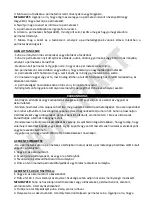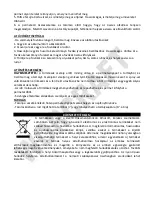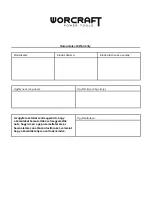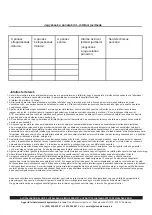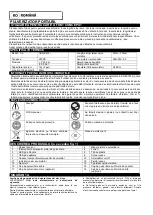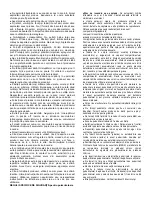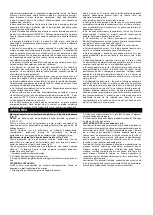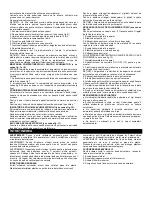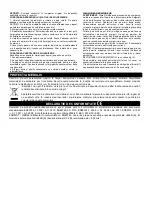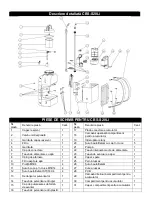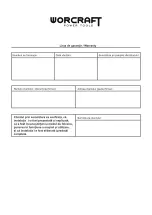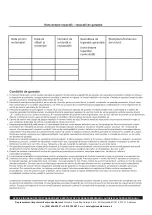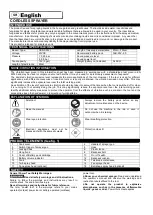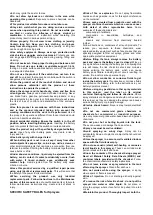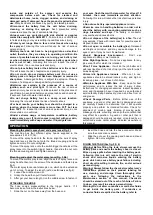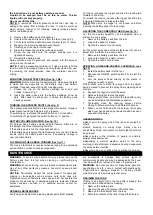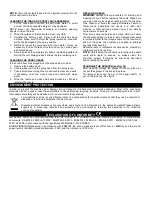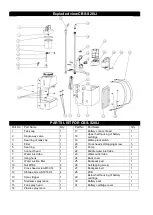
inside and outside of the sprayer and examine the
components before each use. Check for cracked and
deteriorated hoses, leaks, clogged nozzles, and missing or
damaged parts. If damaged, have the product repaired before
use.
Many accidents are caused by poorly maintained products.
●
Disconnect the battery from the unit before draining,
cleaning, or storing the sprayer.
Such preventive safety
measures reduce the risk of accidental starting.
●
Always wear eye protection with side shields or goggles
marked to comply with ANSI Z87.1.
Failure to do so could result
in fluids entering your eyes resulting in possible serious injury.
●
Protect your lungs. Wear a face or dust mask when using
the sprayer.
Following this rule will reduce the risk of serious
personal injury.
●
Battery tools do not have to be plugged into an electrical
outlet; therefore, they are always in operating condition. Be
aware of possible hazards when not using your battery tool
or when changing accessories. Remove battery pack when
tool is not in use.
Following this rule will reduce the risk of
electric shock, fire, or serious personal injury.
●
Do not place battery tools or their batteries near fire or heat.
This will reduce the risk of explosion and possibly injury.
●
Do not crush, drop or damage battery pack. Do not use a
battery pack or charger that has been dropped or received a
sharp blow.
A damaged battery is subject to explosion. Properly
dispose of a dropped or damaged battery immediately.
●
Batteries can explode in the presence of a source of
ignition, such as a pilot light
. To reduce the risk of serious
personal injury, never use any cordless product in the presence of
open flame. An exploded battery can propel debris and chemicals.
If exposed, flush with water immediately.
●
Do not charge battery tool in a damp or wet location
.
Following this rule will reduce the risk of electric shock.
●
For best results, your battery tool should be charged in a
location where the temperature is more than 50°F but less
than 100°F
. To reduce the risk of serious personal injury, do not
store outside or in vehicles.
●
Under extreme usage or temperature conditions, battery
leakage may occur. If liquid comes in contact with your skin,
wash immediately with soap and water. If liquid gets into
your eyes, flush them with clean water for at least 10
minutes, then seek immediate medical attention.
Following this rule will reduce the risk of serious personal
injury.
●
Do not use battery-operated appliance in rain.
●
Exercise care in handling batteries in order not to
short the battery with conducting materials such as
rings, bracelets, and keys.
The battery or conductor
may overheat and cause burns
●
Do not dispose of the battery(ies) in a fire.
The cell
may explode. Check with local codes for possible special
disposal instructions.
●
Do not open or mutilate the battery(ies).
Released
electrolyte is corrosive and may cause damage to the
eyes or skin. It may be toxic if swallowed.
●
Avoid
Dangerous
Environment
-
Don’t use
appliances in damp or wet locations.
●
Use Right Appliance
- Do not use appliance for any
job except that for which it is intended.
●
Don’t Force Appliance
- It will do the job better and
with less likelihood of a risk of injury at the rate for which
it was designed.
●
Store Idle Appliances Indoors
- When not in use,
appliances should be stored indoors in dry, and high or
locked-up place - out of reach of children.
●
Maintain Appliance With Care
- Keep clean for best
performance and to reduce the risk of injury. Follow
instructions for changing accessories. Inspect appliance
cord, and if damaged, have it repaired by an authorized
service facility. Keep handles dry, clean, and free from oil
and grease.
●
Check Damaged Parts
- Before further use of the
appliance, a guard or other part that is damaged should
be carefully checked to determine that it will operate
properly and perform its intended function. Check for
alignment of moving parts, binding of moving parts,
breakage of parts, mounting, and any other condition that
may affect its operation. A guard or other part that is
damaged should be properly repaired or replaced by an
authorized service center unless indicated elsewhere in
this manual.
OPERATION
Mounting the plastic spray head and spray lance(Fig. 2)
The machine has four different spray heads supplied in the
accessories (15,16,17,18).
To mount the spray head onto the lance, align the axis of spray
head and lance, slide the nut onto the thread coupling and hand
tighten securely. Do not overtighten.
To mount the spray lance onto the switch trigger handle,insert the
spray lance into the switch trigger handle, then slide the nut onto
the thread coupling and hand tighten securely.
Mounting and adjust the metal spray lance(Fig. 3 &4)
To mount the metal spray lance, align the axis of spray lance and
spray handle, then turn the screw of the clockwise and fasten.(see
fig.3)
The metal spray lance is a telescopic one, which can be extended
up to 1m long. To adjust the length, just do as follows(see fig.4):
1. Loosen the middle screw nut.
2. Grasp the head then pull it outerforward.
3. After get your desire length, trun the middle screw to fasten it.
ATTACHING THE HOSE
The hose comes preassembled to the trigger handle. If it
becomes loose, follow the instructions below.
1. Slide the nut on the hose away from the hose end.
2.
Insert the hose end into the hose connector. Make
sure the connection is secure.
3.
Slide the nut over the opening and hose end. Hand
tighten. Do not overtighten.
FIILING THE TANK (See fig. 5 & 6)
Warning!
Before filling the tank, always remove the
battery pack and ensure the battery cover is closed.
Wipe up any spills before inserting the battery pack.
Following this rule will reduce the risk of electric
shock and corrosive liquids entering the battery
pack, which can cause battery pack failure including
short circuit resulting in smoke, fire, and/or serious
personal injury.
Warning!
Always follow the chemical manufacturer’s
instructions printed on their product labeling for
use, cleaning, and storage. Clean thoroughly after
each use, following the instructions in the
Maintenance section of this manual. Chemicals
should be stored out of the reach of children. Failure
to do so may result in serious personal injury.
Warning!
Do not allow conductive or corrosive fluids
to get inside the battery pack. If conductive or
corrosive fluids are spilled on the battery, refer to

